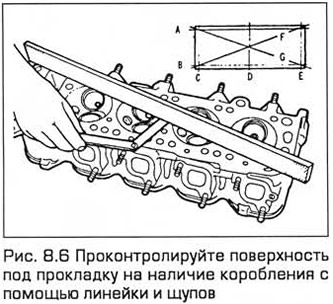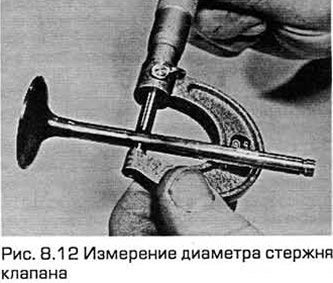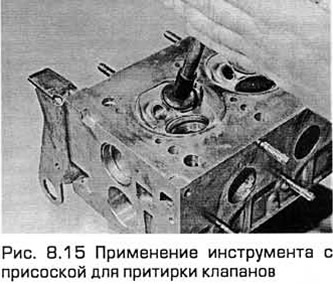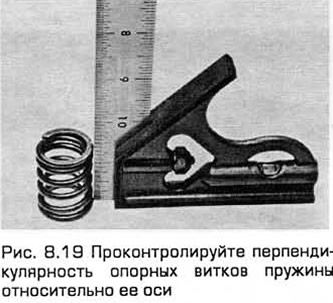Note: If the engine has been overheated, the head may be warped - check it carefully for these signs.
Cleaning
2. Scrape off the old gasket and sealant from the head.
3. Scrape carbon deposits from the walls of the combustion chamber and from the channels. Then thoroughly wash the block head with kerosene or other suitable solvent.
4. Scrape carbon deposits from valves. Then, with a wire brush fixed in an electric drill, remove carbon deposits from the plates and valve stems.
Control
Note: Make sure you have completed all of the following procedures before contacting an auto center or repair technician. Make a list of all items that need attention.
Block head
5. Carefully inspect the block head for cracks, coolant leaks, and other damage. If cracks are found, a new head must be purchased.
6. Check the gasket surface for warpage using a ruler and feeler gauges (see fig. 8.6). If warping is detected, it can be eliminated by machining, provided that the height of the head does not fall below the allowable value.

7. Inspect the valve seats in all combustion chambers. If there are significant signs of pitting, cracking, or fading, it should be replaced or remachined by a specialist. If only slight pitting is found, these can be removed by grinding the valve discs and seats with grinding paste (see below in this paragraph).
8. Check for wear on the guide rod of each valve by rocking it from side to side. In this case, only a very small backlash is allowed. If there is excessive play, remove the valve. Measure the valve stem diameter (see below in this paragraph) and guide. Calculate the operating clearance and if it is greater than the allowable value, replace the valve or guide.
9. Valve guides should be replaced by dealers or engine rebuilders with the necessary equipment.
10. If it is decided to replace or deploy the guides, then in this case it is possible to grind the valve seats only after the work with the guides is completed, if it is more than acceptable, replace the valve or guide.
Valves
11. Inspect the valve discs for signs of pitting, cracks, burnout, and general wear. Check the valve stems for scratches and burrs. Check the valves for distortion as they rotate. Check for pitting or excessive wear at the ends of the valve stems. If these signs of wear or damage are found, replace the valve.
12. In case of a satisfactory result when inspecting the valve, measure the diameter of its stem in several sections with a micrometer (see fig. 8.12). A significant difference in the readings of the micrometer indicates wear on the valve stem. If there is obvious wear, the valve must be replaced.

13. If the valves are in satisfactory condition, they must be lapped into their respective seats to ensure uniform and reliable sealing. If the valve and seat show only slight pitting, or if the seat has been reground, finish with a fine lapping paste. Do not use coarse lapping paste unless there is burnout or significant pitting. In the presence of such defects, the head of the block and the valve must be shown to a specialist for a decision on regrinding the seat or replacing the valve or seat insert (if possible).
14. Lapping of valves is performed as follows. Place the head of the block on the workbench with the top side down.
15. Apply lapping paste to the seat surface, insert the valve and press the valve lapping tool with suction cup against the valve disc (see fig. 8.15). Lapping in a semi-circular motion and periodically lifting the valve to distribute the paste. This work can be greatly facilitated by inserting a weak spring under the valve disc.

16. When using a coarse paste, lap until. until valve and seat surfaces become dull. Then wipe off the rest of the paste and repeat the lapping with the fine paste. Finish lapping when an unbroken light gray ring of constant width is visible on the valve and seat surfaces. Do not continue lapping after achieving this result, otherwise the seat will be prematurely recessed into the head of the block.
17. Once all valves have been lapped, thoroughly wash off remaining paste with kerosene or other suitable solvent before assembling the head.
Valve kit details
18. Inspect the valve springs for damage and discoloration. Measure the length of each spring in the free state, compare it with the same spring from the new set.
19. Install each spring on a plane and check the perpendicularity of the support coils relative to its axis (see fig. 8.19). If any of the springs is damaged or weakened, a new set of springs must be purchased.

20. Inspect the top seats and cradles for wear or cracks, if such signs are found, and if there is any doubt about the serviceability of any part, replace it. Replace lower spring seats/valve stem seals, regardless of condition.
21. Check hydraulic lifters (chapter 2A or 2B).
Visitor comments